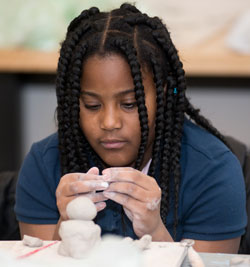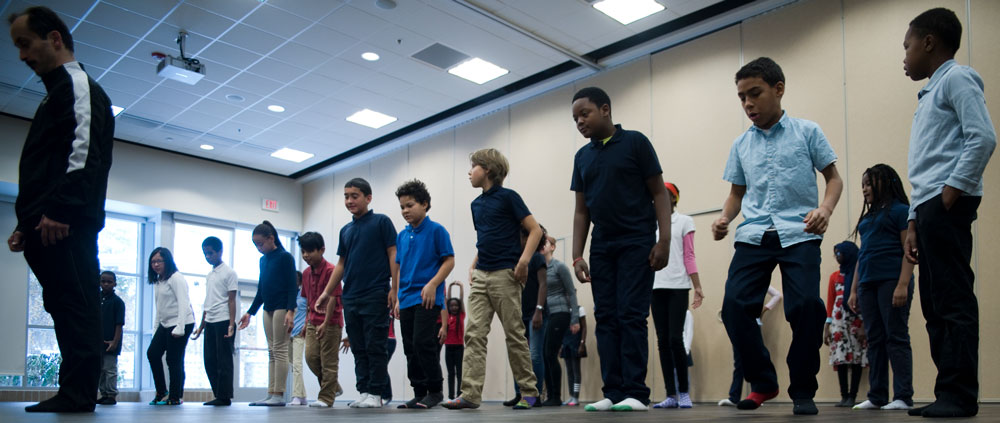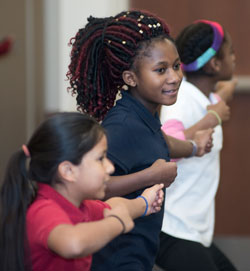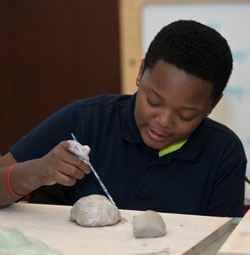In the Fireside room at the Salvation Army Kroc Center, about 20 minutes into a ballet class, Taryn Ortega-Furgeson from the Grand Rapids Ballet School was giving instructions to Kim Monje’s fourth and fifth grade students from nearby Brookside Elementary.
The students, and Ortega-Furgeson, were there as part of the Brookside FAME (Fine Arts Music and Expression) program, a partnership between the school and the center now in its second year.

Ortega-Furgeson was talking about the performance the students will be part of at the Kroc Center on Dec. 17 and giving them some stage logistics.
“This is the point where the second group is coming on stage, so we need to be out of their way,” she said as she surveyed the group. “Cool, cool?” In unison, 27 voices enthusiastically responded: “Cool, cool.”
Ortega-Furgeson smiled and then led the students through what it would look like to be on the stage and then exit. As she did, her colleague Attila Mosolygo, director of the Ballet School, looked on, lending a hand here and there as needed.
After the session, Mosolygo talked about the FAME program and the benefits of ballet for his young charges.
“The lessons they learn go beyond ballet and dance in general,” he said. “The importance of movement is a great habit to teach young students. It is dance, and they don’t think of it as exercise. It is fun, and it also helps them focus better in the classroom.”

‘Search Around and Look for Food’
Fifth grader Averyion Santos echoed those remarks. “I like how we get to move,” he said with a small smile on his face. “It’s fast, and I like the steps we get to do.”
When asked about his favorite part of the dance, he hesitated for a moment, thinking through what they had learned thus far. “I have to say the bow and arrow part,” he concluded at last. “You have to search around and look for food.”
For Averyion, who filled his dance moves with an intense concentration and a big smile, the two hours each week at the Salvation Army Kroc Center are a great fit. “I like singing and dancing and drawing,” he said. “Basically, everything we do at the Kroc Center is what I like to do.”
Fellow fifth graders Onike Kahindo and Isziah Walker were equally enthusiastic.
Onike also liked the bow and arrow move, but really, she said, “I just like to move.” Isziah, who displayed a pair of nimble feet, was a little more pragmatic. “I like it,” he said of the dancing. “It strengthens my legs and stuff so I can do better at sports.”

Sessions Enhance Classroom Teaching
Monje, their teacher, was part of the inaugural FAME program last spring which offered bucket drumming, mural painting and a ballet class and saw an average of 90 fourth and fifth grade students weekly. This year, third grade was added, and participation is now almost 160 students.
She thoroughly enjoys both the time at the Kroc Center and the ways in which the sessions enhance her teaching.
“The jazz portion gives them an opportunity to learn about great jazz musicians as well as practicing their listening skills,” she said. “In the art and ballet portions, students must be able to listen to and follow multi-step directions. During the ballet time, students are using math skills without even being aware they are using them.”
Brookside principal Melissa Wozniak is equally enthusiastic about FAME. She’s also grateful to her backyard neighbor for making it — and a variety of other options — available to her students.
“We have been able to partner to provide after-school programming, mentoring, swim lessons and now this new additional fine arts programming,” she said.
The program, noted Alyson Rodriguez, fine arts supervisor for the Kroc Center, is currently paid for by a grant from The Salvation Army to promote and increase fine arts exposure.
“Once the grant is finished,” she added, “we are hoping the community will continue to support the FAME initiative.”

Ballet, Clay and Jazz
FAME sees students walk to the Center, just west of the school at 2500 S. Division Ave., for six weeks and rotate through 35- to 40-minute fine arts classes. Students work toward the Dec. 17 end-of-session performance, as well as a gallery showing in conjunction with their school showcase.
This fall, ballet is one of three sessions for the five Brookside classrooms of third, fourth and fifth graders. The other two are clay and jazz, and students in Monje’s class were equally attentive in those two sessions.
Indeed, after the major movements of ballet, things slowed down a little – but not completely – during the clay session, led by Rodriguez, who said the program is one of the favorite parts of her job. This time the class was seated, but they were busy with their hands, first slamming the clay down and then beginning to mold it.
The slamming part, which many of the students did with vigor, is called wedging, Rodriquez said, and it’s one of the most important steps of working with clay.
“It helps to get the air bubbles out,” she said. “If there are air bubbles in the clay it can explode in the kiln during firing, and that can damage their project and others.”
Bunnies, Tigers, Turtles and More
This day, the next step after wedging was the process of turning the clay into an animal, based on discussion in prior weeks with Rodriquez.
“The first week we talked about animals that can symbolize character traits or something significant for us individually,” she said. “I wanted to focus on the art process for this because a good portion of the students have never worked with clay before, so they started with a sketch the first day, then learning specific techniques and then they were able to start building animals.”
As fifth grader Zaide Lorenzana was making a bunny that she planned to name Abby, she talked about how much fun she was having.
“This is really satisfying to play with,” she said, “and you are making things out of it. I like that we can learn new things, things we can even do at home.”
For their final FAME stop, Monje’s students spent time with Dean Wiers-Windemuller of Southtown Guitar.

“Who can tell me the name of the first jazz musician we learned about?” he asked the class as they settled into their seats.
Quickly came the answer: “Louis Armstrong.” Another student called out: “He played the golden trumpet.”
Wiers-Windemuller smiled. “What about the next one?” he asked.
“Duke Ellington,” several students shouted.
“Yes,” Wiers-Windemuller replied. “Yes. Duke was a piano man. Who was next?”
“Bessie Smith.”
“Yes. She was a singer. Today is another singer. Today is Billie Holiday.”
And then, with the lights low and the children quietly coloring a picture of Holiday, Wiers-Windemuller began to read to them about Holiday from a book called “Giants of Jazz” by Studs Terkel.
“It was late at night,” he began. “The little girl sat on the kitchen floor, her chin cupped in her hands, as the old, old lady told her a story. She knew so many: beautiful tales remembered from slavery days, others recalled from the Old Testament.”
As he told them the beautiful tale of Billie Holiday, the room grew quiet, his melodious voice and the gentle touch of pencils on paper the only sounds in the room.
CONNECT
Check out Brookside Elementary’s Facebook page
Learn more about the Kroc Center and fine arts
















